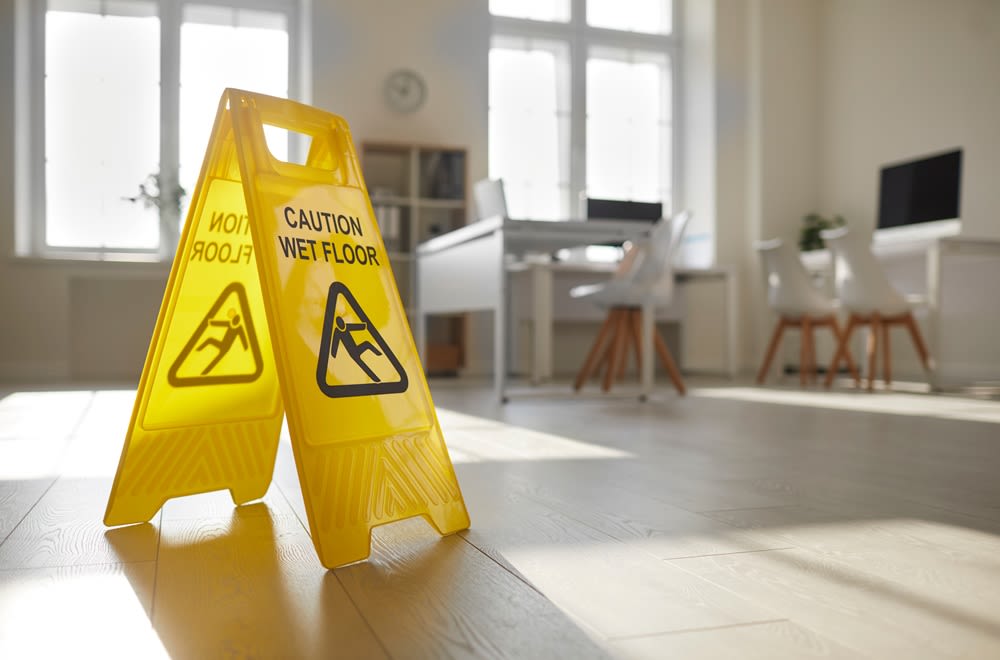
Fall protection should be at the top of your to-do list as an employer or supervisor. In particular, it’s smart to focus on preventing same-level falls. These incidents can result in significant injuries and illnesses that could cost your company money.
The good news is there are simple changes you can make that can have a big impact in preventing these falls. Here’s what you need to know about how to prevent same-level falls and keep your staff and visitors safe.
What Are Same-Level Falls?
Same-level falls are incidents in which a person encounters an obstacle and goes from standing to hitting the ground. Unlike other types of falls, these incidents don’t really involve height. Instead, they are moments in which someone goes from standing to kneeling or lying on the ground in a few moments.
According to the National Safety Council, more than 275,600 cases of same-level falls resulted in problems like missed days of work or job restrictions from 2021 to 2022. On average, people missed 12 days of work due to these incidents. In some cases, the injuries sustained can be serious and long-lasting.
8 Ways to Prevent Same-Level Falls
The Occupational Safety and Health Administration (OSHA) requires employers to prevent same-level falls. These are good options for anyone to consider to avoid these sorts of incidents:
1. Remove Obstacles
Same-level falls often occur due to issues like debris, cords, and clutter. Make a point to walk your worksite regularly and remove anything that obstructs a clear walkway for your staff and visitors. For example, if you have to string cords or lines across walkways, do so temporarily and tape them to the ground. Consider making these safety sweeps part of someone’s regular job duties.
2. Choose the Right Flooring
If you’re opening a new job site, choose the right flooring. For example, concrete in a warehouse may make for easy mopping, but it could also crack and cause a trip and fall. Work with a contractor and ensure that the substrate you choose is both easy to keep clean and less likely to cause falls.
3. Clean Up Spills
Flooring that is clean and dry is less likely to cause a slip and subsequent fall. Ensure that your staff has easy access to cleaning materials like mops and rags, and make sure that everyone considers cleaning their personal responsibility. Prompt cleaning can save an employee or visitor from a ball fall. Get help from a professional and perform deep cleaning regularly.
4. Use Signage
Appropriate signs can alert your staff to problems you haven’t fixed quite yet. For example, if you have an uneven slope on your floor and you’ve hired someone to fix it, use a sign to tell staff that an issue is present. You can also use signs for things like wet floor cleanups that have happened and haven’t dried yet.
Ensure that the signs come down when the problem disappears. Otherwise, those signs become invisible instead of helpful. Make the process for signage and signage removal clear for all employees.
5. Install Protective Gear
Some workplace problems are very difficult or impossible to fix. For example, you may have manholes or walkways that could present fall hazards, but they can’t be removed without destroying your environment. Talk to a contractor about installing railings, hole covers, or toe boards around these hazards, so your staff always stays safe. Your facility’s OSHA point of contact may also have good ideas about issues that require a permanent fix.
6. Train Your Workers
Employers may know the OSHA requirements inside and out. However, their staff may need help recognizing what same-level falls look like and how they can be prevented. Employees may also need to realize that ignoring prevention could lead to consequences (such as job termination).
Holding regular training sessions could ensure that employers and staff work as a team to keep everyone safe. When the goals are clear, teammates can all work to accomplish them together.
7. Install Proper Lighting
It’s easier to experience a same-level fall when the room is dark and the floor is hard to see. All spaces that staff will walk on during the workday should be properly lit. Bright lighting is especially important in egress spaces, but any space where someone could potentially fall should be flooded with light.
8. Require Appropriate Footwear
Many employers have dress codes that encourage staff to wear appropriate clothing to work. Those guidelines should also cover fall prevention. Shoes with high heels, open toes, and chunky platforms can make falls much more likely.
Require your staff members to wear shoes that are appropriate for the work, and hold routine inspections to ensure that people comply. Don’t be afraid to use consequences (like suspensions) for repeat offenders. If you don’t enforce these guidelines, they can become meaningless.
9. Put Safety First
Staff members who run from place to place may get a significant amount of work done, but they may also get hurt in their hurry to move. Ensure that your staff recognizes that they’re responsible for safety and don’t take shortcuts that put their health at risk. Outline safety as the top priority for everyone in the workplace.
Alsco Uniforms Fall Prevention Help
Whether you need help with deep cleaning, routine cleaning, floor mats, or more, Alsco Uniforms can help. Our services can ensure that your environment is safe for employees and compliant with OSHA regulations. With our expert guidance, the process of making your workplace safer becomes easier. Contact us to find out more today.
References
Falls: Same Level. National Safety Council.
Fall Protection. Occupational Safety and Health Administration.
Fall Prevention Practices and Implementation Strategies: Examining Consistency Across Hospital Units. (January 2022). Journal of Patient Safety.
Fall Prevention Research and Practice: A Total Worker Safety Approach. (August 2014). Industrial Health, National Institute of Occupational Safety and Health.
